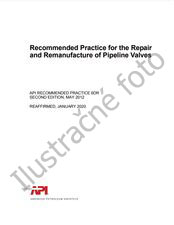Potrebujeme váš súhlas na využitie jednotlivých dát, aby sa vám okrem iného mohli ukazovať informácie týkajúce sa vašich záujmov. Súhlas udelíte kliknutím na tlačidlo „OK“.

API RP 934-E-ed.2
Recommended Practice for Materials and Fabrication of 11Cr-1Mo Steel Pressure Vessels for Service above 825 °F (440 °C)
NORMA vydaná dňa 1.1.2018
| Dostupnosť | Vypredané |
| Cena | NAOTÁZKU bez DPH |
| NA OTÁZKU |
Informácie o norme:
Označenie normy: API RP 934-E-ed.2
Dátum vydania normy: 1.1.2018
Kód tovaru: NS-1140286
Počet strán: 27
Približná hmotnosť: 81 g (0.18 libier)
Krajina: Americká technická norma
*) Pri tovare, ktorý nie je na sklade a musí sa objednávať u vydavateľa sa budú počítať aj skutočné náklady na dopravné a balné. Ich výšku Vám oznámime na základe vášho odkazu na e-mail info@normservis.sk, resp. na telefónnom čísle + 420 566 621 759.
Anotácia textu normy API RP 934-E-ed.2 :
API RP 934-E, 2nd Edition, January 2018 - Recommended Practice for Materials and Fabrication of 11Cr-1Mo Steel Pressure Vessels for Service above 825 °F (440 °C)
This recommended practice (RP) includes materials and fabrication requirements for new 11Cr-1Mo and 1Cr-1Mo steel pressure vessels, including heat exchanger shells and channels for elevated temperature service. It applies to vessels that are designed, fabricated, and documented in accordance with ASME Code Section VIII, Division 1 or Division 2 (hereafter referred to as “Code”).
This document may also be used as a resource when planning to modify existing pressure vessels.
The interior surfaces of these pressure vessels and heat exchangers (i.e. the surfaces exposed to the process) may or may not have an austenitic stainless steel (SS), ferritic SS, or nickel alloy weld overlay or cladding to provide additional corrosion resistance.
Some 11Cr-1Mo and 1Cr-1Mo components with thicknesses greater than 4 in. (100 mm) have been shown to have difficulty meeting the Code toughness requirements. This recommended practice is primarily intended for wall thicknesses less than 4 in. (100 mm); a preferred option for thicker components is to use 21Cr-1Mo alloys.
This RP is applicable to shell thicknesses greater than 1 in. (25 mm). Although outside of the scope, this document can be used as a resource for vessels down to lower shell thicknesses with changes defined by the purchaser.
This RP is intended for use for 11Cr-1Mo and 1Cr-1Mo equipment operating between 825 °F (440 °C) and 1150 °F (620 °C). The primary in-service materials degradation mechanism addressed by the requirements herein is low creep ductility (LCD) cracking, which can occur at these operating temperatures if not properly addressed. LCD cracking is a form of reheat cracking.
In many cases, 11Cr-1Mo and 1Cr-1Mo steel equipment being designed for temperatures >825 °F (>440 °C) operate with stresses below the threshold for brittle fracture [i.e. below 8 ksi (55 MPa) as reported in API 579-1/ASME FFS-11, or below 10% of ultimate tensile strength as reported in literature].
Typical equipment covered by the scope of this RP includes catalytic reforming reactors and fluidized catalytic cracking (FCC) unit hot wall reactors. For information on 11Cr-1Mo and 1Cr-1Mo equipment operating at lower temperature ranges, refer to API RP 934-C. Since hydroprocessing units are typically operated at temperatures lower than 825 °F (440 °C), the guidelines in this RP (934-E) do not apply to most hydroprocessing units; instead, they are covered by RP 934-A or 934-C. Also, since coke drums typically are more susceptible to fatigue than LCD cracking, this RP excludes coke drums from the scope; they are addressed in API Technical Report 934-G.



 Cookies
Cookies
